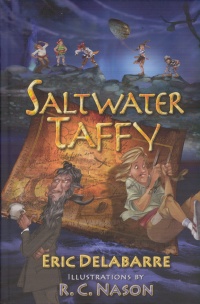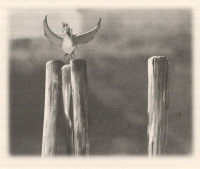| ________________
CM . . . . Volume XVII Number 30 . . . . April 8, 2011
excerpt:
Thirteen-year-old Scott and his friends embark on the hunt for the lost treasure of Jean Lafitte, a pirate whose descendants devised a complicated search activity that has enthralled their Washington State town for decades. Finding the third of four keys that are to lead to the treasure, they are thwarted in their search by a gang of bullies and an old hermit who possesses the first two keys and the maps they uncovered. They share a series of adventures that takes them into the danger of a collapsing cave tunnel, a steep river gorge, the old man's scary mansion, and a marauding black bear, all the while attempting to salvage their minor baseball team's poor season. Finally in possession of the full treasure map, they deem it to be a hoax and give up, until, on his own, Scott figures it out and finds the real treasure hidden in the bell tower of the local library. Having discovered that real treasure is in the life you lead, he decides to forego the fortune and hide his discovery from his friends, just in time to score the winning home run for his team.
The inanities in this book are numerous and would make any proper book editor cringe. Confronted by the bullies who are attempting to find the third key before them, the boys throw "M-80s" at them; the author makes no explanation, but an M-80 is an explosive device banned in the U.S. since the 1960s. How convenient, then, that their illegal grenades just happen to explode the tree that pulls a cable out of the river and lifts out the box containing the key. Which makes one wonder how the Lafitte estate could ever plan their treasure hunt, if it depended on such a chance occurrence. In fact, the entire series of keys, ciphers, and maps that lead to the treasure is so baffling and contradictory that it is doubtful even the author understands it. In the above excerpt, the X on the map is discovered by placing the handwritten cipher text over the map – an inexplicable occurrence. And that's not all. The old hermit tries to kill them, and yet the boys never involve the authorities and don't seem to mind that he shows up at their baseball game. Zippy falls into the gorge and is presumed dead after a long search along the river, and yet he shows up two hours later, uninjured, claiming his backpack kept him afloat. The bear chasing them turns out to be running from hunters, and, in an episode completely unrelated to the plot, the group expound on how cruel hunting is (but never mention how chasing a bear is probably not the stealthiest way to hunt). Every time Scott looks at the treasure map, he keeps looking for what he calls an "X-marks-the-spot" because, you know, every treasure map must have an X-marks-the-spot (even inexplicable ones). And when Scott finally figures out the map, it's because he notices invisible ink markings on it as it catches the sun in a certain way; after that, the map is completely readable to him at all times. The ending, where Scott decides that the treasure is really his friendships and that the gold and silver don't matter, is handled in such an awkward and clunky way as to be completely unbelievable. The forced marriage of a clumsy mystery and a forced moral does not work. Not recommended. Todd Kyle is the CEO of the Newmarket Public Library in Ontario and has served on the jury of a number of children's literature awards.
To comment
on this title or this review, send mail to cm@umanitoba.ca.
Copyright © the Manitoba Library Association. Reproduction for personal
use is permitted only if this copyright notice is maintained. Any
other reproduction is prohibited without permission.
NEXT REVIEW |
TABLE OF CONTENTS FOR THIS ISSUE
- April 8, 2011.
AUTHORS |
TITLES |
MEDIA REVIEWS |
PROFILES |
BACK ISSUES |
SEARCH |
CMARCHIVE |
HOME |

 Set in the early 1970s, this novel from American television writer/director Eric DelaBarre (illustrated by Canadian R. C. Nason) trumps itself as Indiana Jones meets Stand By Me. And yes, it does have tons of adventure and a tale of bonding and friendship in difficult times, but there the resemblance ends. What this book does have is extremely poor writing, inconsistent and often inexplicable plotting, and a narrator who, try as he might to sound like a moody teenager, keeps straying into the kind of pandering, clichéd insights into life that manage to both belie and insult his youth. In fact, the book ends with a "final word" that expounds on these observations and invites readers to download the author's self-help companion book. The question it begs: why did he write a novel when he so obviously wanted to just tell us a moral?
Set in the early 1970s, this novel from American television writer/director Eric DelaBarre (illustrated by Canadian R. C. Nason) trumps itself as Indiana Jones meets Stand By Me. And yes, it does have tons of adventure and a tale of bonding and friendship in difficult times, but there the resemblance ends. What this book does have is extremely poor writing, inconsistent and often inexplicable plotting, and a narrator who, try as he might to sound like a moody teenager, keeps straying into the kind of pandering, clichéd insights into life that manage to both belie and insult his youth. In fact, the book ends with a "final word" that expounds on these observations and invites readers to download the author's self-help companion book. The question it begs: why did he write a novel when he so obviously wanted to just tell us a moral?